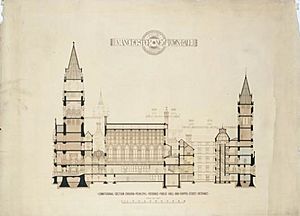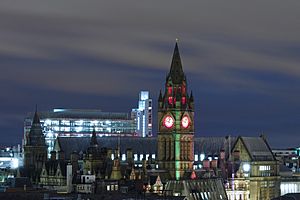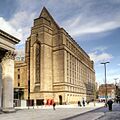Manchester Town Hall facts for kids
Quick facts for kids Manchester Town Hall |
|
|---|---|
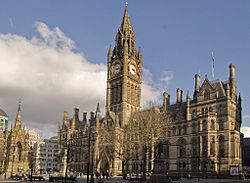 |
|
| General information | |
| Type | Town hall |
| Architectural style | Gothic Revival / High Victorian Gothic |
| Classification | |
|
Listed Building – Grade I
|
|
| Designated: | 25 February 1952 |
| Reference #: | 1207469 |
| Location | Manchester, England |
| Address | Town Hall Albert Square Manchester M2 5DB |
| Construction started | 1868 |
| Completed | 1877 |
| Inaugurated | 13 September 1877 |
| Cost | £775,000 – £1,000,000 (£53,360,000 to 68,860,000 as of 2025 ) |
| Owner | Manchester City Council |
| Height | Clock tower – 280 feet (85 m) |
| Technical details | |
| Floor count | 6 |
| Design and construction | |
| Architect | Alfred Waterhouse |
The Manchester Town Hall is a really impressive old building in Manchester, England. It was built in the Victorian times and looks like a grand Gothic castle. This building is the main place for the Manchester City Council. It's where they have important meetings and offices.
The Town Hall faces Albert Square on one side and St Peter's Square on the other. A famous architect named Alfred Waterhouse designed it. The building was finished in 1877.
Inside, you'll find offices and amazing rooms like the Great Hall. This hall is famous for its Manchester Murals, which are huge paintings showing the city's history. In the entrance and Sculpture Hall, there are statues of important people from Manchester, like scientists John Dalton and James Joule. Outside, a tall clock tower stands out, reaching 280 feet high! It holds a huge bell named Great Abel.
In 1938, a newer part called the Town Hall Extension was built. It connects to the main building with two covered bridges. The Manchester Town Hall is so important that it was made a Grade I listed building in 1952. This means it's a very special historical building.
Contents
History of Manchester's Town Hall
The First Town Hall
Before the current grand building, Manchester had a smaller Town Hall. It was located on King Street and was built between 1822 and 1825. This first Town Hall was designed by Francis Goodwin.
It had a classic look with tall columns. Inside, there were offices for city officials and rooms for public meetings. The building and land cost about £39,587 back then.
As Manchester grew bigger and richer, especially because of the textile industry, the city needed a much larger building. The old Town Hall became too small. After it was no longer used for city business, it became a library and then a bank.
Building the New Town Hall
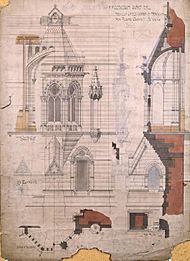
Plans for the new Town Hall started in 1863. The city leaders wanted a building that was "equal if not superior" to any other similar building in the country. They wanted it to be central, easy to get to, and in a nice area.
They chose an unusual triangular plot of land facing Albert Square. This spot was perfect because it was close to banks and other city offices. The land was big enough to show off a magnificent building.
A competition was held to find the best design. Many architects entered, but Alfred Waterhouse was chosen on April 1, 1868. His design was praised for its quality and how well it used light.
The first stone was laid on October 26, 1868. It took nine years to build and used 14 million bricks! The cost was huge, somewhere between £775,000 and £1,000,000. That would be many millions of pounds today.
The Manchester Town Hall officially opened on September 13, 1877. The mayor, Abel Heywood, who strongly supported the project, opened it.
The Town Hall Extension
As the city continued to grow, more space was needed. In 1927, another competition was held to design an extension. Emanuel Vincent Harris won this competition. He also designed Manchester's Central Library.
Work on the extension began in 1934 and was finished by 1938. This new part is connected to the main Town Hall by covered walkways on the first floor.
Modern Updates
By 2014, the Town Hall needed a lot of repairs and updates. The city council planned to fix the heating and electrical systems, repair windows, and work on the stonework and roof. These repairs, including improvements to Albert Square, were estimated to cost around £2.2 million.
Architecture of Manchester Town Hall

Building in Victorian cities was tricky because of pollution and crowded spaces. Architects had to think about light, noise, and how buildings would look with all the smoke. Alfred Waterhouse made sure there was enough light inside the Town Hall. He used special windows, skylights, and even glazed white bricks to brighten up darker areas.
The building shows off the Gothic revival style. This means it looks like medieval Gothic buildings from the 13th century. You can see this in its low arched ceilings and tall, pointed windows. The Gothic style was chosen to connect with Manchester's history in the textile trade.
Even though it looks old, the building was very modern for its time. It had gas lighting and a special heating system that brought in fresh, warm air. Waterhouse also designed the building to be fireproof, using concrete and strong iron beams.
Outside the Town Hall
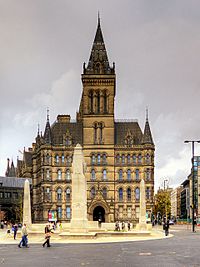
In the mid-1800s, many buildings in Manchester turned black from air pollution. Waterhouse chose tough Pennine sandstone for the Town Hall. He knew it would stand up to Manchester's weather and pollution.
He also chose interior decorations that would stay colorful and be easy to clean. Public hallways were covered in terracotta instead of plaster. There were also stone arched ceilings and washable mosaic floors.
Waterhouse's design was a bit simpler than some other Gothic buildings of the time. He didn't use many different colors on the outside. He thought Manchester's industrial air would quickly ruin colorful designs. Statues of important people from Manchester's history decorate the outside. You can see Agricola, who founded the Roman fort, above the main door. There's also St George and other figures like Humphrey Chetham.
The Clock Tower
The clock tower is 280 feet tall. It's one of the tallest buildings in Manchester. Inside, it has a set of 23 bells. Twelve of these bells are used for change ringing, a special way of ringing bells.
The main clock bell is called Great Abel. It weighs over 8 tons! Four of the ringing bells are used for the famous Westminster Clock Chime. The clock was made by Gillett and Bland.
The clock bell first rang on New Year's Day in 1879. It cracked later and had to be replaced in 1882. All the bells were recast in 1937. The clock face has a message from the Bible: Teach us to number our Days. The Great Abel bell also has the initials AH for Abel Heywood and a line from a poem: Ring out the false, ring in the true.
Inside the Town Hall
Waterhouse's design made the most of the triangular plot of land. He created a six-story building. Around the outside, there are corridors connecting offices. The grand, ceremonial rooms are in the center.
Near the main entrance on Albert Square, two grand staircases lead to the Great Hall. These stairs have low steps, which made it easier for women in long Victorian dresses to climb them. The walls of the staircases have tall, arched windows that let in lots of daylight. There are also three spiral staircases made of different types of granite.
Sculpture Hall
The Sculpture Hall is on the ground floor. It holds statues and busts (head and shoulders sculptures) of people who did great things for Manchester. These include Richard Cobden and John Bright, who fought against the Corn Laws, and scientists John Dalton and James Joule.
This room is 53 feet long and 33 feet wide. It has a beautiful arched ceiling made of Bath stone. Today, there's a café in the Sculpture Hall.
The Great Hall
The landing outside the Great Hall has a glass skylight. On the glass, you can see the names of all the mayors and leaders of Manchester since 1838. The floor has a mosaic pattern of bees and cotton flowers, which are symbols of Manchester. A famous critic named John Ruskin once called the Great Hall "The most truly magnificent Gothic apartment in Europe."
The hall is 100 feet long and 50 feet wide. Natural light comes in from seven tall windows on each side. The ceiling is shaped like a wagon roof and has panels with the coats of arms of countries and towns that Manchester traded with.
The walls are decorated with The Manchester Murals by Ford Madox Brown. These are 12 large paintings that show important moments in Manchester's history.
There's also a huge organ in the Great Hall. It was installed in 1877 and has more than 5,000 pipes! It's been cleaned and updated over the years.
-
Statue of John Dalton in entrance vestibule, sculpted 1837 by Francis Leggatt Chantrey
-
Statue of James Prescott Joule in entrance vestibule, sculpted 1893 by Alfred Gilbert
What the Town Hall is Used For Today
Council meetings are usually held in the Town Hall Extension now. However, the main Town Hall is used for many other things. It's a popular place for weddings and other special events. You can also hire it for conferences. Sometimes, tour companies offer tours of the famous clock tower.
Because the Town Hall looks a bit like the Palace of Westminster (where the UK Parliament meets), it's often used as a filming location. Movies like Sherlock Holmes (2008), The Iron Lady (2011), and Victor Frankenstein (2014) were filmed here. The TV series A Very English Scandal (2018) also used it to look like the inside of the Palace of Westminster.
In 2014, a 24-hour police station reopened in the Town Hall. It had been closed since 1937. The new station doesn't have cells, but officers can interview people there. The police chief said it was "perfectly placed in the hub of the city."
In June 2016, the Town Hall was used to announce the official results of the EU Referendum for the whole country.
Images for kids
See also
 In Spanish: Ayuntamiento de Mánchester para niños
In Spanish: Ayuntamiento de Mánchester para niños



